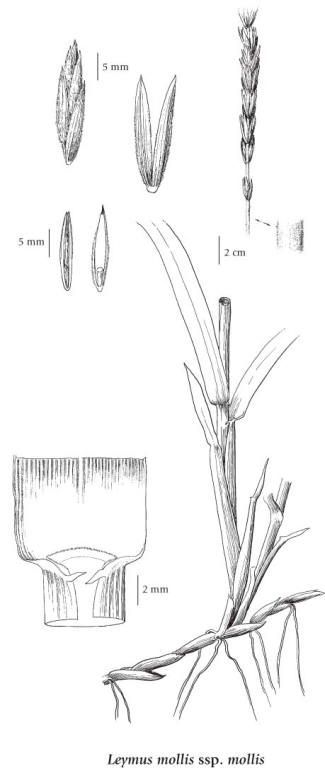Leymus mollis (Trin.) Pilg. subsp. mollis
dune wildrye (American dunegrass)
Poaceae (Grass family)
Introduction to Vascular Plants
dune wildrye (American dunegrass)
Poaceae (Grass family)
Introduction to Vascular Plants
Species Information click to expand contents
General:
Perennial, tufted grass from thick, ascending rhizomes forming large clumps; stems erect, stout, usually finely but copiously hairy or sometimes smooth above, 50-150 cm tall.
Leaves:
Sheaths open, smooth; blades tough, very finely minutely rough appressed-hairy on the upper surfaces and smooth underneath, with numerous prominent nerves, flat to in-rolled, 6-15 mm wide; ear-shaped lobes usually developed at some leaf-bases; ligules more or less fringed with fine hairs, scarcely 1 mm long.
Flowers:
Inflorescence a stout spike, (10) 15-30 cm long, 1-2 cm wide; spikelets paired, 4- to 6-flowered, unstalked or if occasionally short-stalked then inflorescence slightly compounded, 20-30 (33) mm long; glumes lanceolate, usually soft-hairy but sometimes only sparsely short-hairy, prominently 3- to 6-nerved and flat, at least at the base, usually membranous-margined, long-pointed, mostly nearly equal to the spikelets, 15-25 mm long, awn-tipped; lemmas generally copiously soft-hairy but rarely only sparsely hairy, mostly prominently-nerved, membranous-margined, 10-20 mm long, long-pointed to abruptly slender-tipped, but scarcely awned; anthers 5-9 mm long.
Notes:
A hybrid between Leymus mollis and Elymus glaucus, known only from Ucluelet and Gold River, has been named Leymus x uclueletensis (Bowden) Baum (Elymus x uclueletensis Bowden). A second hybrid, which is infrequent in SW BC, Leymus x vancouverensis (Vasey) Pilger (Elymus vancouverensis Vasey), has been proposed as a hybrid between Leymus mollis and L. triticoides (Buckl.) Pilger. See Hitchcock et al. (1969) for more detailed descriptions of these hybrids.
Illustration click to expand contents

If more than one illustration is available for a species (e.g., separate illustrations were provided for two subspecies) then links to the separate images will be provided below. Note that individual subspecies or varietal illustrations are not always available.
Illustration Source: The Illustrated Flora of British Columbia
USDA Species Characteristics click to expand contents
Flower Colour:
Yellow
Blooming Period:
Late Spring
Fruit/Seed characteristics:
Colour: Brown
Present from Summer to Fall
Source: The USDA
Ecology click to expand contents
Ecological Framework for Leymus mollis ssp. mollis
The table below shows the species-specific information calculated from
original data (BEC database) provided by the BC Ministry of Forests and Range.
(Updated August, 2013)
The table below shows the species-specific information calculated from
original data (BEC database) provided by the BC Ministry of Forests and Range.
(Updated August, 2013)
| Site Information |
Value / Class |
||
|
Avg |
Min |
Max |
|
| Elevation
(metres) |
3 | 0 | 11 |
| Slope
Gradient (%) |
7 | 0 | 40 |
|
Aspect (degrees) |
0 | ||
| Soil
Moisture Regime (SMR) [0 - very xeric; 4 - mesic; 8 - hydric] |
2 | 1 | 6 |
| Modal
Nutrient Regime
Class |
A | ||
| #
of field plots species was recorded in: |
7 | ||
| Modal
BEC Zone Class |
CWH | ||
|
All BEC Zones (# of stations/zone) species was recorded in |
CWH(7) | ||
|
Source:
Klinkenberg 2013
|
|||
Habitat and Range click to expand contents
Moist to mesic sandy or gravelly beaches and shoreline forests in the lowland zone; common in coastal BC; amphiberingian, N to AK, YT and N, E to NF and S to NH, PA, MI, IL and CA; Greenland, E Asia.
Status Information click to expand contents
Synonyms click to expand contents
Synonyms and Alternate Names:
Elymus arenarius
Elymus arenarius subsp. mollis (Trin.) Hultén
Elymus arenarius var. scabrinervis (Bowden) B. Boivin
Elymus arenarius var. villosus E. Mey.
Elymus capitatus Scribn.
Elymus mollis Trin.
Elymus mollis var. mollis
Leymus arenarius subsp. mollis (Trin.) Tzvelev